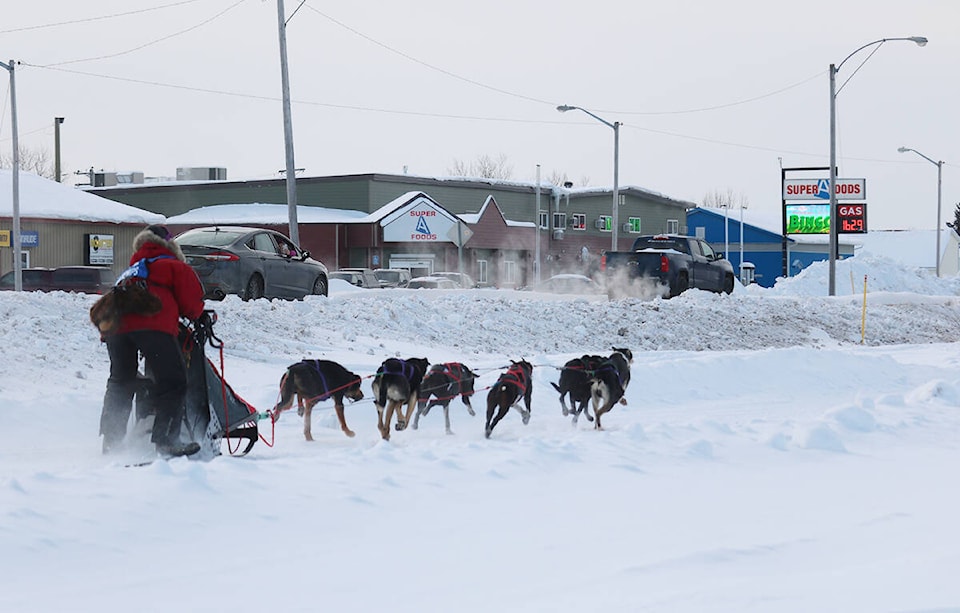The dog races have been among the biggest highlights that have brought pleasant memories for organizers and attendees of K’amba Carnival.
Terry Camsell, who was born and raised in Hay River on the reserve, spent about 10 years organizing the festival from the late eighties to nineties.
Now residing in North Vancouver, he said that the festival brings back many treasured thoughts of getting the dog races going.
“I came in to help organize a few years after the carnival was created in 1982,” he said. “When I started (K’amba) was very small and very limited in terms of what they offered.”
After helping out carnival organizers for a few years, he joined the organizing committee in the late eighties and pushed to introduce a dog race as well as a talent show.
“We started the dog race and the talent show in 1989 and they have been going every year since,” Camsell said.
“The first year I knew nothing about running a dog race and I just had to kind of play it by ear.”
With the help and advice of Randy Buggins, Camsell said that he aimed to have a mass start of 10-dog teams racing two laps around Vale Island.
“The dog racers always wanted time starts and they would petition me every year to have time starts,” he said chuckling. “I always resisted and said I know you guys (racers) like time starts but the spectators love mass starts.
“It is a pretty exciting time when you have all those teams already to go and taking off at one time and vying for a position down the chutes and into one line.”
Camsell said the dog race feature of the carnival gained in popularity quickly and included 29 10-dog teams in 1997 from across the NWT as well as the United States, Alaska, Alberta, Saskatchewan, British Columbia and Alberta.
Buggins, who is participating again this year, remembers fondly how the dog race added to the carnival’s overall allure, especially in the late nineties and 2000s.
“They had to put in three chutes - the width of the river basically,” he said. “After that the average has been sometimes 20 teams and usually no less than 14 teams.”
Buggins agreed that the mass starts were a big hit at K’amba up to about two years ago. Because of concern over ice conditions in recent winters, the race was held along the highway.
“The river ice became questionable because of low water and the snow cap was breaking through where the water was shallow so they didn’t want to risk it,” he said. “So the last time we just ran from the Super A towards Enterprise.
“We’re doing the same thing this year because the river froze up rough and it is hard to put in the track. You don’t want to hurt the dogs.”
While he enjoys the competition and believes the quality of the race has gotten better over the years, Buggins said he just likes being around his dogs.
“Everybody has good dogs now and whoever puts in the proper training does well,” he said. “I grew up around dogs and my uncles used to trap with dogs. So we always had dogs.”
Another racer, Anthony Beck, said he spent about 15 years at the K’amba race before finally winning. He is planning on entering the six-dog race and always liked being able to mush in front of Hay River crowds.
“I’ve raced it many years and obviously with it being my hometown, it’s always exciting to to do well,” he said. “When you have fans and people that come out and sponsors you always want to be able to do good for them.”
Beatrice Lepine spent about 15 years between the 1900s and 2000s volunteering to help organize and coordinate the races and helped record race timing.
Now retired from organizing, she said as a spectator she has been pleased with how the dog race has contributed to the legacy of K’amba.
“We did (the dog race organizing) together for a long time and I have fond memories of it,” she said. “It was hard work and it was an intense experience.
“We often had a lot of teams come in from the US and other southern provinces but it varied from year to year what we would get and it often depended on the race circuit down south.”
Lepine said being able to have a winter carnival in Hay River and K’atlodeeche First Nation after 40 years is an important accomplishment and should be attributed to the reserve’s commitment to community every year and the energy of the region’s volunteers.
“It’s a marvel really every year, with the volunteers on the reserve and in town,” she said.
“It’s a five or six day carnival total but for me it was always the weekend event with the dog races.”
